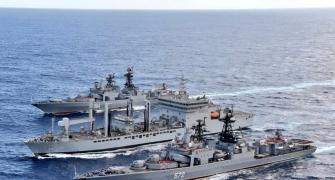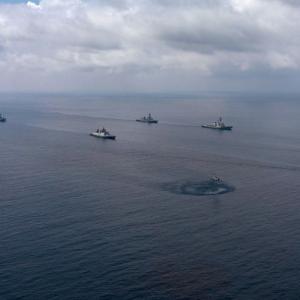There is concern about the poor state of readiness of the navy's 140 warships which face severe shortages in sonar equipment, helicopters and torpedoes, reveals Ajai Shukla.
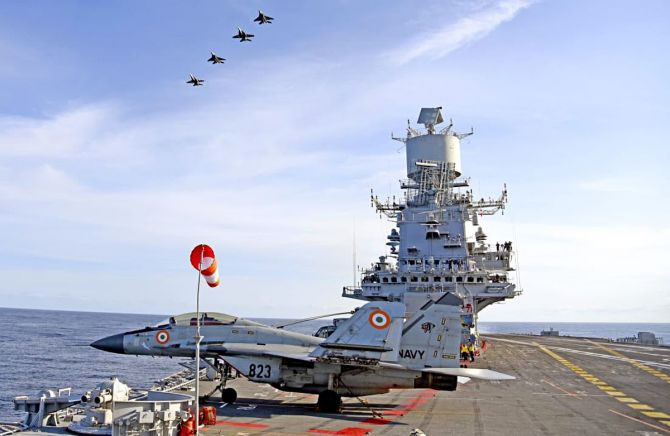
The quadrilateral Exercise Malabar, involving the American, Australian, Japanese and Indian navies, has been a thumping success.
With two aircraft carrier battle groups participating -- one American and one Indian -- the three Indian capital warships that exercised, along with an Indian Scorpene submarine and a P-8I maritime reconnaissance aircraft, got a valuable opportunity to train with the best equipped navies of the world, say senior naval admirals.
Yet, there is concern in South Block at the poor state of readiness of the navy's 140-odd warships, which face severe shortages in sonar equipment, helicopters and torpedoes – equipment critical for a warship's survival and combat power.
Like almost every Indian warship built after 1997, the aircraft carrier INS Vikramaditya and the two destroyers, INS Kolkata and INS Chennai, participated in Malabar without 'advanced towed array sonar' (ATAS), essential for detecting enemy submarines in the shallow Arabian Sea where the peculiar temperature and salinity gradients sharply limit the effectiveness of conventional sonars.
Without ATAS, enemy submarines can sneak up to within 50-80 kilometres of these warships and launch their torpedoes from standoff ranges.
Most Indian warships also function without another vital anti-submarine warfare (ASW) platform: Naval Multi-Role Helicopters (NMRH), which fly low over the sea and lower 'dunking sonar' into the water in order to listen for audio signals from enemy submarines.
While the navy signed a contract for 24 MH-60 Romeo multi-role choppers in February, it is currently left with just about ten obsolete Seaking helicopters, of which no more than four-to-five are usually operational at any time.
In addition, there are eight Kamov-28, of which four-to-five are available. These ten-odd choppers must be distributed amongst the navy's 40-odd capital warships.
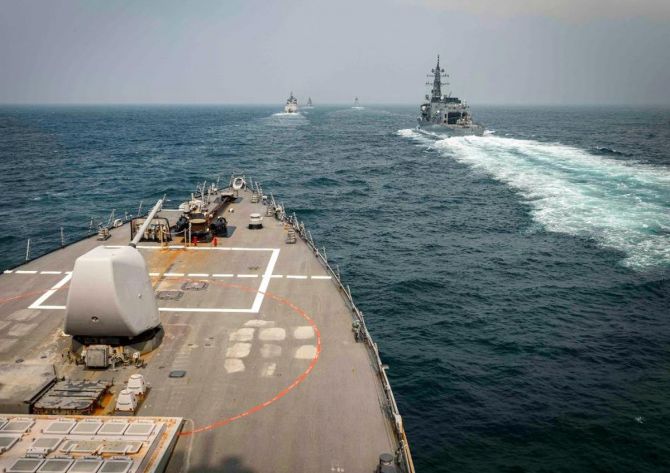
In 2014, towards addressing the dire shortage of ATAS sonars, the defence ministry signed a contract with German marine electronics leader, Atlas Elektronik, for six advanced towed array sonar.
Six years later, just two ATAS have been installed on warships so far. One major reason is that the navy keeps changing the warships on which they are to be installed.
For example, with INS Mysore going into medium refit and likely to be out of action for a couple of years, its ATAS is being transferred to the destroyer, INS Delhi.
Transferring an ATAS from one ship to another is costly and painstaking. Cutting the helicopter deck to install the winch inside could take three months.
Another six months or so are spent on pre-harbour trials harbour trials and field evaluation trials.
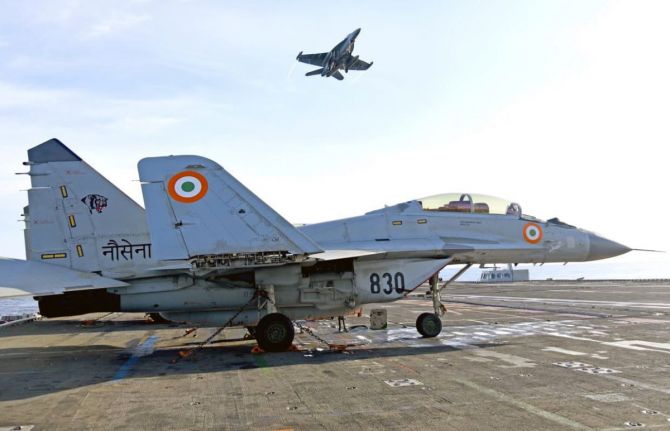
Nine more ATAS sonars are being procured from Atlas Elektronik in a contract that is before a cost negotiating committee.
Even though this is a follow-on contract to the six ATAS already bought, the Defence Acquisition Procedure requires that it goes through the entire procurement procedure, except for field evaluation trials (FET).
Were there an options clause in the earlier contract, the next tranche of procurement would be classified as a 'repeat contract', and would have followed a greatly simplified procedure.
Another four ATAS sonars are going through the glacial procurement procedure for the four Project 1135.6 Krivak-class frigates, the first two of which are being manufactured in Russia and the other two in Goa Shipyard Ltd, India. Bids have been submitted for the first two sonars, but the process drags on.
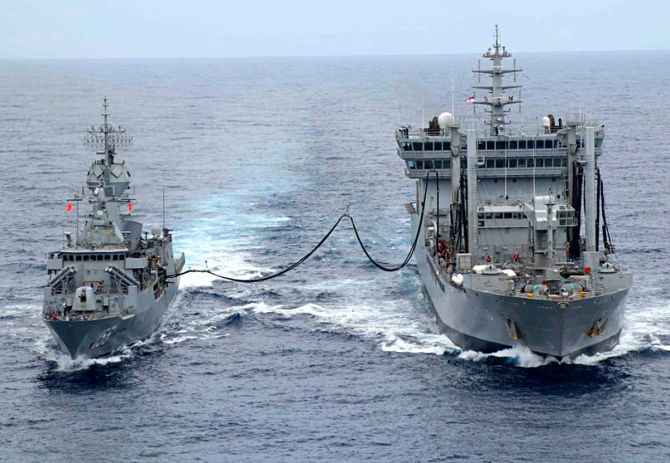
Given ongoing tensions with China, the navy urgently needs to equip its submarines with state of the art torpedoes.
But the heavyweight torpedoes (HWT) needed to equip the navy's frontline Scorpene submarines have not been procured.
The urgency of this requirement was underlined in August 2014 when the ongoing procurement of 98 Black Shark torpedoes for the Scorpene from Italian marine specialist, Whitehead Alenia Sistemi Subacquel (WASS), was scrapped after its parent company, Finmeccanica, was banned by the MoD in the wake of the VVIP helicopter scandal.
When the Black Shark contract was put on hold, it became obvious that India's vintage arsenal of 98 old SUT torpedoes, would be required to arm the Scorpene-class.
The SUT torpedoes were bought in the 1980s and 1990s for the navy's four Type 209 submarines. However, with some modifications, they could be used from the Scorpene as well.
Atlas Elektronik was called in to carry out a life-cycle extension that would extend the service life of 64 SUT torpedoes by 15 years.
Another contract was signed by the Indian Navy with Atlas Elektronik last month to extend the life of the remaining 32 SUT.
With the army facing off against China in Ladakh, New Delhi has urged Atlas to hasten the life-extension of the remaining 32 torpedoes.
However, Berlin requires mandatory procedures, such as the issue of a contract, for granting an export licence.
Meanwhile the procurement of new HWTs drags on, the choice reduced to a two-horse race between Atlas Elektronik's Seahake torpedo; and French firm, Naval Group's F-21.
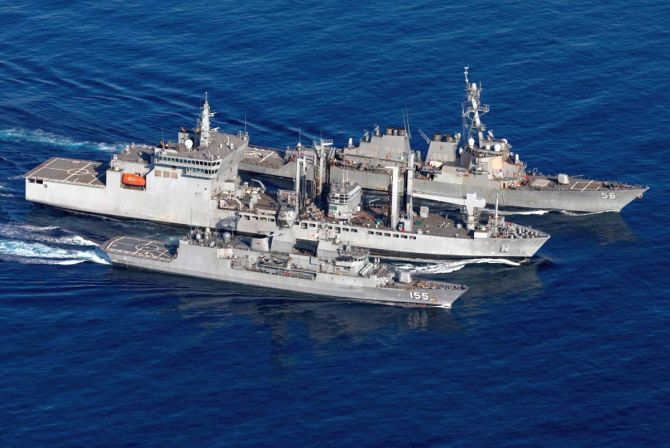
As defence minister, Manohar Parrikar pushed in 2015-2016 for a straightforward government-to-government arrangement with Berlin to buy Atlas Elektronik's Seahake.
That was scuttled by his return to Goa as chief minister in 2017. Arun Jaitley, who succeeded him, was too preoccupied with his finance portfolio.
Nirmala Sitharaman, the next defence minister, took time to settle down, by when the elections took place and Rajnath Singh replaced her. He has reverted to pursuing a global tender.
However, the procurement has been derailed by the pandemic.
The technical evaluation of the torpedoes has been completed, but the live testing, which has to be done in Germany, is held up since no foreign visitors are being permitted into German military facilities.
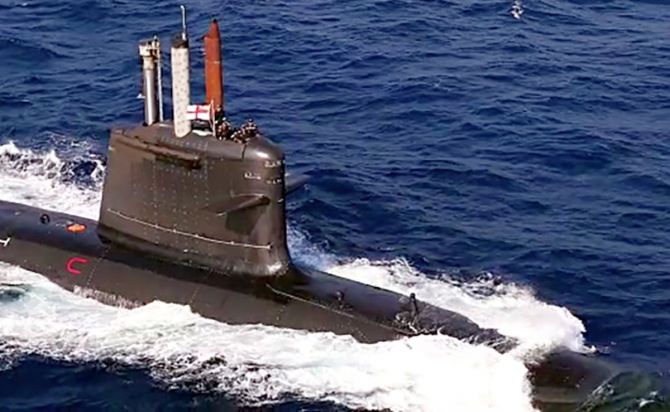
Also floundering is the Project 75I project to construct six submarines with air independent propulsion in India.
With slow progress, the navy is considering upgrading and giving life cycle extensions to the Kilo-class, Type 209 and Scorpene submarines, to maintain capability till the Project 75I submarines are inducted.
Many believe it is unrealistic to plan to fit lithium-iron batteries and AIP into these old submarines.
Even so, this is now probably inescapable since, even if the RFP is released immediately for Project 75I and the procurement goes according to plan it would still be 10-12 years before the first Project 75I submarine becomes operationally available.
Feature Presentation: Rajesh Alva/Rediff.com



